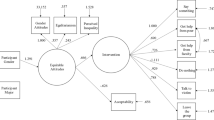Abstract
Previous research has indicated sex differences in style of interaction for members in small groups. It was assumed that some of these sex differences could be attributed to demand characteristics in relation to specific topics discussed by group members in earlier investigations. The purpose of the present study was to investigate the relative importance of two such demand characteristics, decision rule (consensus rule vs. majority rule), and decision consequence (high vs. low consequences), in addition to the sex composition of the group membership. Adherence to the group decision was also studied. On a topic previously rated as important, 16 four-person groups of males and the same number of female groups met and deliberated on a decision regarding an academic policy. Later these undergraduate students indicated their preference on the decision topic. The results showed male—female differences not accounted for by decision rule, decision consequence, or group decision post-test change. Explanation of the sex differences was offered in terms of varying academic aspiration levels and incongruency with attained academic achievement. The results also lend partial support for the importance of some operating demand characteristics, as yet unidentified.
Similar content being viewed by others
References
Beddell, J., & Sistrunk, F. Power opportunity costs, and sex in a mixed-motive game. Journal of Personality and Social Psychology, 1973, 25, 219–226.
Beloff, H. Two forms of social conformity: Acquiescence and conventionality. Journal of Abnormal and Social Psychology, 1958, 56, 99–104.
Black, T. E., & Higbee, K. L. Effects of power, threat and sex on exploitation. Journal of Personality and Social Psychology, 1973, 27, 382–388.
Bond, J. R., & Vinacke, W. E. Coalitions in mixed-sex triads. Sociometry, 1961, 24, 61–75.
Christie, R. Scale construction. In R. Christie & F. L. Geis (Eds.), Studies in Machiavellianism. New York: Academic Press, 1970.
Costanzo, P. R., & Shaw, M. E. Conformity as a function of age level. Child Development, 1966, 37, 967–975.
Davis, J. H., Kerr, N. L., Atkin, R. S., Holt, R., & Meek, D. The decision processes of 6- and 12-person mock juries assigned unanimous and two-thirds majority rules. Journal of Personality and Social Psychology, 1975, 32(1), 1–14.
Denmark, F. L., & Diggory, J. C. Sex differences in attitudes toward leaders' display of authoritarian behavior. Psychological Reports, 1966, 18, 863–872.
Epstein, G. F., & Bronzaft, A. L. Female modesty in aspiration level. Journal of Counseling Psychology, 1974, 21(1), 57–60.
Exline, R. V. Explorations in the process of person perception: Visual interaction in relation to competition, sex, need for affiliation. Journal of Personality, 1963, 31, 1–20.
Grey, L. N., Mayhew, B. H., & Campbell, R. Communication and three dimensions of power: An experiment and a simulation. Small Group Behavior, 1974, 5(3), 289–320.
Hall, J. Decisions, decisions, decisions. Psychology Today, November 1971, 5, 51–54, 86–87.
Jones, J. M. Reactive effects of pretesting and test length in attitude research. Psychological Reports, 1973, 33, 107–114.
Lana, R. E. Assumptions of social psychology. New York: Appleton-Century-Crofts, 1969.
Lockheed, M. E., & Hall, K. P. Conceptualizing sex as a status characteristic: Applications to leadership training strategies. Journal of Social Issues, 1975, 32(3), 111–124.
Manbridge, J. J. Time, motion, and inequality: Three problems of participatory groups. Journal of Applied Behavioral Science, 1973, 9, 351–368.
McClelland, D. C., Atkinson, J. W., Clark, R. A., & Lowell, E. L. The achievement motive. New York: Appleton-Century-Crofts, 1953.
Orne, M. Demand characterstics and the concept of quasi-controls. In R. Rosenthal & R. L. Rosnow (Eds.), Artifacts in Behavioral Science. New York: Academic Press, 1969.
Pauling, J. F. & Lana, R. E. The effects of pretest commitment and information upon opinion change. Educational and Psychological Measurement, 1969, 29, 653–663.
Robinson, R. C. A study of the individual and comparative utilities of compromise and consensus conditions. Unpublished doctoral dissertation, University of Oregon, 1973.
Rosnow, R. L., Holper, H. M., & Gitter, A. C. More on the reactive effects of pretesting in attitude research: Demand characteristic or subject commitment? Educational and Psychological Measurement, 1973, 33, 7–17.
Tuddenham, R. D. The influence of a distorted norm upon individual judgment. Journal of Psychology, 1958, 46, 227–241.
Vinacke, W. E. Sex roles in a three person game. Sociometry, 1959, 22, 343–360.
Author information
Authors and Affiliations
Rights and permissions
About this article
Cite this article
Klopfer, F.J., Moran, T. Influences of sex composition, decision rule, and decision consequences in small group policy making. Sex Roles 4, 907–915 (1978). https://doi.org/10.1007/BF00287710
Issue Date:
DOI: https://doi.org/10.1007/BF00287710



